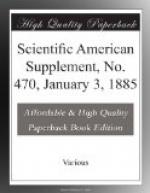FLOW OF WATER THROUGH HOSE PIPES.
At a recent meeting in this city of the American Society of Civil Engineers, a paper by Edmund B. Weston was read, giving the description and result of experiments on the flow of water through a 21/2 inch hose and through nozzles of various forms and sizes; also giving the results of experiments as to the height of jets of water. The experiments were made at Providence, R.I. The water was taken from a hydrant to the head of which were attached couplings holding two pressure gauges, and from the couplings the hose extended to a tank holding 2,100 gallons, so arranged as to measure accurately the time and amount of delivery of water by the hose. Different lengths of hose were used. The experiments resulted in the following formula for flow from coupling:
1. For hose between 90 and 100 feet in length, and where great accuracy is required:
---------------------------------------------------
/ 2gh
V = / ---------------------------------------------------
/ / 0.504 \
\/ 1 - 0.0256d^{4} + ( 0.0087 + ------- ) 0.12288d^{4}l.
\ —– /
\/ v
[TEX: V = \sqrt{\frac{2gh}{1 — 0.0256 d^4 + (0.0087 + \frac{0.504}{\sqrt{v}}) 0.12288 d^4 l}}.]
2. For all lengths of hose, a reliable general formula:
----------------------------------------------
/ h
V = / ----------------------------------------------
\/ 0.0155463 — 0.000398d^{4} + 0.0000362962d^{4}l.
[TEX: V = \sqrt{\frac{h}{0.0155463 — 0.000398 d^4 + 0.0000362962 d^4 l}}.]
g being velocity of efflux in feet per second. h, head in feet indicated by gauge. d, of coupling in inches. l, length of hose in feet from gauge. v, velocity in 21/2 inch hose.
Forty-five experiments were made on ring nozzles, resulting in the following formula:
f = 0.001135v squared.
f being loss of head in feet owing to resistance of nozzle, and v the velocity of the contracted vein in feet per second.
Thirty-five experiments were made with smooth nozzles, resulting in the following formula:
f = 0.0009639 v squared.
f being the loss of head in feet owing to resistance, and v the velocity of efflux in feet per second.
Experiments show that a prevailing opinion is incorrect that jets will rise higher from ring nozzles than from smooth nozzles.
Box’s formula for height of jets of water compares very favorably with experimental results.
* * * * *




